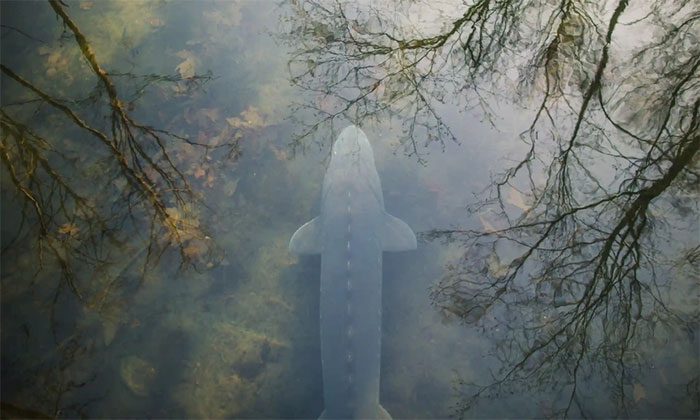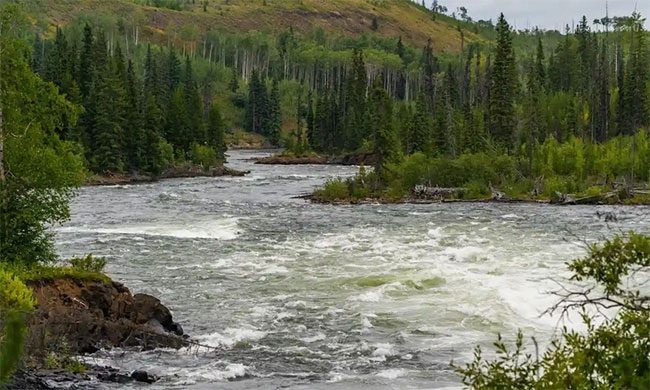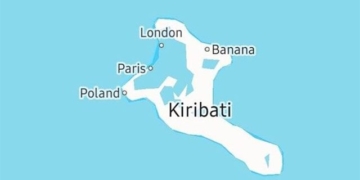Eleven sturgeons suddenly died en masse in the Nechako River (Canada) within just a few days, leaving scientists perplexed and calling for assistance from the community.
Upon discovering the first sturgeon carcass in the Nechako River, British Columbia, in early September, Nikolaus Gantner and two colleagues quickly boarded a boat, navigating through swift currents to investigate this tragic phenomenon, according to the Guardian.
Days later, they found the carcasses of 10 more sturgeons drifting along a 100 km stretch of river in western Canada.
These 11 white sturgeons—an endangered species—mysteriously died in a short period, baffling biologists.
The Mysterious Deaths
This species has remained virtually unchanged for 200 million years. They are toothless predators, gracefully gliding beneath the murky waters of a few rivers in British Columbia.
To navigate the murky waters, sturgeons gently glide their whisker-like barbels along the gravel bottom.

White sturgeon in the Fraser River, British Columbia, Canada. (Photo: Alarmy).
White sturgeons, with their bodies covered by five distinct bony plates known as scutes, resemble prehistoric fish. The largest recorded individual was over 6 meters long, and another, believed to be 104 years old, weighed nearly 816 kg.
“When you see a massive head emerge from the murky water, it’s hard to believe this majestic creature is still alive. And most of them are older than we are,” said Gantner, a senior biologist with the British Columbia government.
The consecutive deaths have taken Gantner and his colleagues by surprise.
“I’m very saddened. For the past few weeks, I feel like I’m going through a period of mourning,” he said. Each time he and his colleagues transferred the giant carcasses from the shore to the freezer and onto the autopsy table, he felt a pang of sorrow.
“I don’t think I would feel this way about other fish,” he added.
So far, there are no clear answers regarding the deaths of these sturgeons. The research team found no signs of injury or evidence of chemical exposure or disease.
“Whatever it is, it affects large sturgeons and not other species. (This phenomenon) is limited in time and space at one location. So that gives us some clues,” said Steve McAdam, a biologist with the regional land, water, and resource management agency.
The deaths in the Nechako are particularly painful for McAdam, who studied a similar incident in the lower Fraser River in 1993 and 1994, where 36 sturgeons died over two years.
McAdam stated that a series of subsequent tests could not reach a conclusion. Events occurring in different ecosystems, hundreds of kilometers apart, provided limited clues for investigators.
Currently, the time to recover dead sturgeons before they decompose and lose valuable clues is rapidly diminishing, prompting the investigation team to call for public assistance.
A variety of hypotheses have been proposed, including rising temperature conditions. However, McAdam noted that there have been no similar fish kill events in previous hot summers.
“We’re trying to keep an open mind and not just focus on one avenue,” he said.
A Warning
Before this mysterious die-off occurred, white sturgeons had already been facing significant challenges and were listed as a federally endangered species.
In the past century, the number of sturgeons in the Nechako River has decreased from over 5,000 to 500. Shortly after a dam was built on the Nechako River in 1957, this species experienced what biologists call a “failed” reproductive recovery.

Nechako River, where the sturgeon population has decreased from 5,000 to 500 over the past century. (Photo: Alamy).
Human impacts have led to the degradation and shrinkage of sturgeon habitats in many parts of the world.
In China, the spoon-billed sturgeon has been confirmed extinct in a report published on July 21 by the International Union for Conservation of Nature (IUCN), largely due to human impact, according to National Geographic.
In British Columbia, all rivers where sturgeons once thrived have also been “devastated” by dams.
Since 2001, British Columbia has been working to restore this species. They have called upon the participation of provincial and federal biologist groups, along with sectors related to sturgeon habitats, such as hydroelectric dam operators.
The province has also allocated $10 million to build and operate a sturgeon conservation center on the Nechako River in Vanderhoof, according to the Globe and Mail.
However, the sudden deaths of 11 individuals recently reflect a global trend: Sturgeons have become the most threatened fish species.
All 26 remaining species of sturgeon are at risk of extinction. They are victims of overfishing, as the roe of certain species, such as the beluga sturgeon, is highly valued like caviar. Their habitats are also gradually disappearing.
The sudden deaths of the sturgeons have surprised biologists partly because white sturgeons have been closely studied and monitored for the past three decades due to their precarious status.
“This happened within a week. We have another big question, truly perplexing,” said Gantner.
Both Gantner and McAdam hope this event will provide deeper insights for biologists about what has happened and how to prevent a similar scenario.
“We’ve never tested the complete removal of them and witnessed the true importance of sturgeons to the ecosystem. Personally, I don’t think we want that to happen,” McAdam shared.





















































